For most Australians, hot water heat pumps are the most energy-efficient way to heat water.
According to installers we trust, what are the best brands in Australia in 2025?
How Did We Survey Our Installers?
We asked the 594 installers in the SolarQuotes installer network one question:
If installing a system on your own house today, what brand’s hot water heat pumps would you use?
89 installers replied. Here are the results.
Best Hot Water Heat Pumps In Australia: 2025

Best Hot Water Heat Pumps 2025: First place – iStore
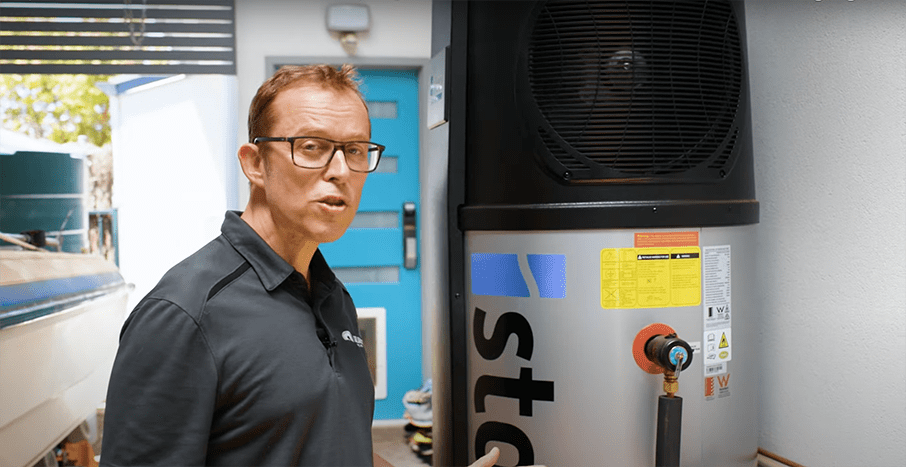
My mate Sean’s iStore all-in-one heat pump. It hasn’t missed a beat.
With 29% of the vote, iStore claims the top spot.
iStore has been selling heat pumps in Australia for a decade, with their current generation product (pictured above) hitting the market 6 months ago.
They only sell “all in one” heat pumps using propane refrigerant. Price-wise, they’re firmly midrange.
They have a good heating speed, high efficiency, and quiet operation, and only need a regular 10A electrical socket, which can save $500-$1500 in installation costs if it saves an electrician running a dedicated supply from your switchboard.
Disclosure: iStore is a sister company to solar panel installer Solargain, and many Solargain dealers are SolarQuotes clients.
Best Hot Water Heat Pumps 2025: Second place – Solahart
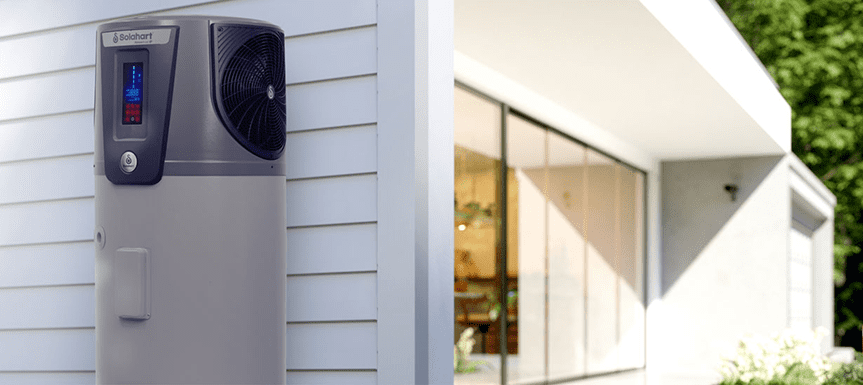
Solahart’s Atmos heat pump
Taking second place with 19% of the vote is Solahart.
Solahart has been selling old-school solar thermal hot water in Australia for over 70 years. They’ve seen the writing on the wall and recently added heat pumps to their product range with their current generation Atmos series.
I haven’t seen a Solahart heat pump in person yet, so I’ll hold off on a personal verdict until I get more feedback on their reliability. Some of these units are made by Solahart’s sister company, Rheem, which has a, let’s say, patchy track record with reliable heat pumps, so I was surprised to see them perform well in the awards. Hopefully, this means the quality of Rheem’s newer models has finally stepped up a notch.
Disclosure: Solahart has a national dealer network of solar panel installers, and many are also SolarQuotes clients.
Best Hot Water Heat Pumps 2025: Third place – Reclaim Energy
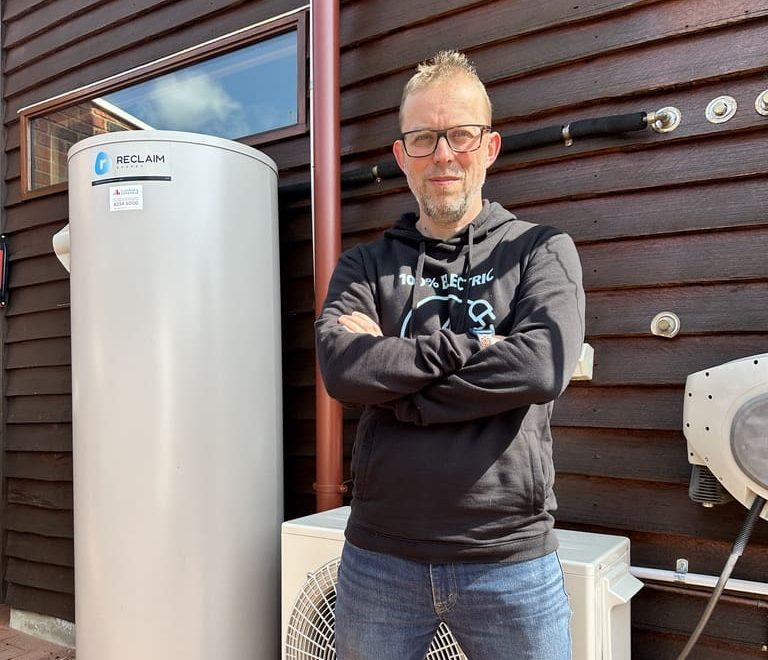
My Reclaim hot water heat pump.
Just behind Solahart, Reclaim Energy took third with 17% of the vote. It is a split-system design with the tank and compressor separate.
I chose one for my home because:
- they use CO2 refrigerant – making them more efficient than heat pumps using other refrigerants
- the split system design is whisper-quiet in operation
- they have a 10-year warranty – compared to 5 years for most others
All of these features come at a cost – you’re looking at north of $6000 fully installed before rebates.
What Do These Heat Pumps Cost?
My hot water heat pump comparison table shows pricing for all the winners, plus heaps of other brands.
To compare the cost of this year’s winners:
- iStore (270L) – $2,800
- Solahart (280L) – $3,500
- Reclaim (315L) – $5,000
These prices don’t include local heat pump rebates or heat pump STCs, which together can take approximately $700-$2000 off.
They also don’t include installation costs. A difficult install – involving a new dedicated drain line, a concrete slab base for the water tank, and a long electrical run back to the switchboard – could add $3,000 or more. An easier install will add closer to $1,000.
Useful Heat Pump Resources
You now know which brands installers like best, but what does the Australian public prefer? Find out in our top 10 heat pump hot water systems according to Australian reviewers.
If you are thinking of upgrading your hot water to a heat pump, I spent ages writing this comprehensive dummies guide to hot water heat pumps.
If you want to see how much you can save with hot water rebates:
- Use our Hot Water Heat Pump STC calculator to find the ‘federal’ rebate for your postcode and model
- Then see if you have any extra local hot water rebates listed here.
And if you’re looking to get a heat pump for your home – we now offer up to three quotes for heat pumps from great installers.

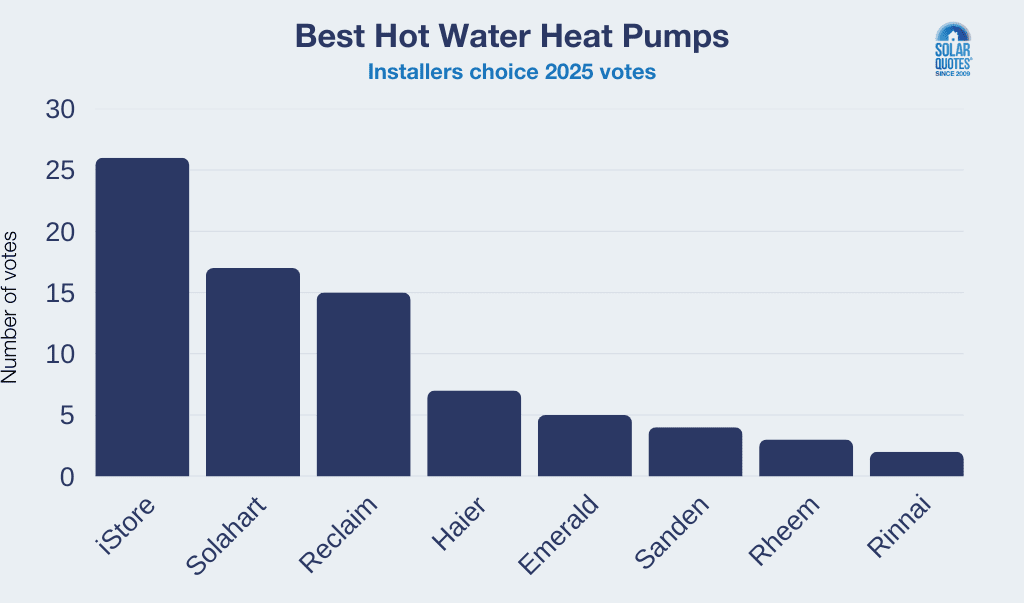
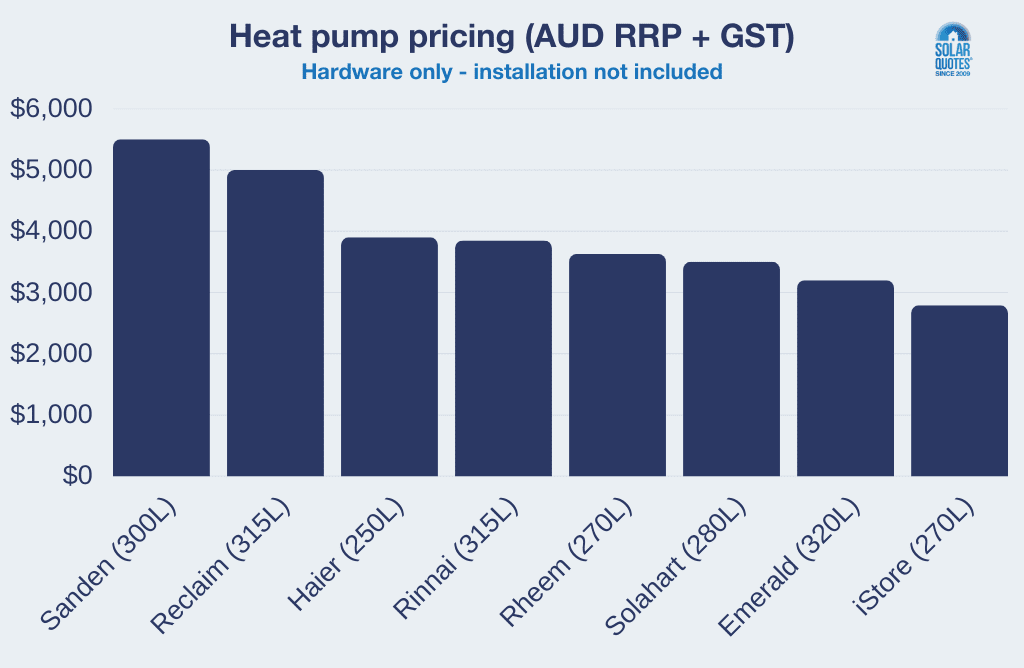
 RSS - Posts
RSS - Posts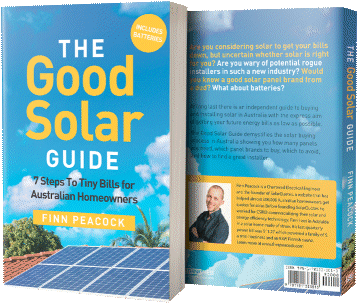


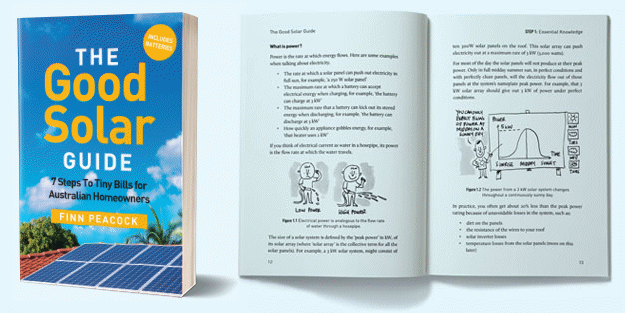
Definitely on my list. Living in one of the coldest parts of Australia, there aren’t any remaining reliability issues in sub-zero temperatures for these? Have seen others go through horrendous experiences with these installs, in our area, though they may have bought crap systems and had bad installers. Also follow-up maintenance, having sdomebody local if needed to do call outs. We use heat pumps to do all the home heating, so big fan of the technology.
Hi Nick,
You need a CO² refrigerant unit for cold climates I believe.
Great, thanks was already looking at Reclaim so that’s another good reason.
Look at the Sanden as well. I got one 2 years ago. It’s on par with the Reclaim one but I found the price after installation and rebates to be better. Could be different now though.
Will do, also near top of my list.
I installed a sanden CO2 unit 6 years ago, have had perfect, lower cost hot water since. Couldn’t be happier. They do cost a bit but quality is top notch.
Thanks for the article guys.
Vote for standard reporting of performance.
The number of STCs a unit gets accurately represents the expected energy savings.
Claiming performance at 32 deg and COP6 claiming to be the best available…..
Please!
XXXXXXX’s own website says their unit takes 4hrs to heat 315L from 17-63 degrees in 20 deg ambient. That’s COP 4.4 based on their 850W nominal power Input. Not COP6 it says two paragraphs earlier (fine print at 32deg)
Many heatpumps using R290 of later designs will be at that or better.
An Istore for example gets COP4.82 at 19degC ambient heating a full tank of water from 15-60degC.
We need standard advertising allowable not stuff at 32deg which is unrealistic for most of Australia.
All heatpumps are good heatpumps – article fails to mention heating power / reheat rate which is a significant factor in the expected life. Can’t expect a heatpump running 7 hrs a day is going to last as long as one running 3.5hrs a day.
I work for Istore –
No need to run it in subzero temperatures, heatpump stores energy just like a battery. Charge it during the day when it’s warmer is much more efficient as warmer air carries more energy.
Refrigerant gasses make little difference if the evaporator has turned into a block of ice. That happens anytime the evaporator is below zero and there is Moisture in the air.
There are three sizes of heatpumps
small has 2.0kW heating power
Medium has 2.7kW heating power
Large has 4.0kW heating power
These are rated at 19degC
Add 10DegC gain 25% more performance
Take away 10deg C loose 25% performance
Give or take a couple of percent this is true for all air conditioners, heatpumps, fridges etc.
The choice of refrigerant gasses in our mild climate is irellevant.
People love high performance heatpumps because they still have enough performance in winter. They don’t get their rated performance at 19deg because it’s closer to 10 deg.
If you start with a low powered heatpump in cold conditions its a really low powered heatpump and may not be able to get the job done during daylight hours when it’s warm and it has its best chance.
If you buy a high powered heatpump it will typically heat a cold tank in winter in 4 hrs which you can run in the middle of the day, this will deliver about 400L of shower temp water which is enough for 4 normal people with room to spare.
If you need more take it off the timers or exclude peak periods or run two schedules.
Disclaimer – I work for Istore
Thanks, and yes a very good point, I’d be doing most hot water heating in daylight hours.
I’ve had a Reclaim system in Armidale NSW for 3 years after ditching instant gas. Payback with family of 4 was 2.5 years. It’s great.
The cheap ones have a bad name around here as they don’t work in cold climates. I was surprised to see them in this list.
Reclaim has anti-freeze/frost features which give peace of mind. Super efficient, draws around 0.8kwh in summer and 2kwh in winter
Great feedback, thanks, and a not dissimilar climate.
Hi Nick
Cold climates – the coldest average wintertime daytime temperature in Australia according to the BOM is Mt Bulla with 4.7deg C.
every 10 degrees or so affects the performance of a heatpump by 20%.
It simply needs to run a little longer to get the job done.
EG https://www.sanden-hot-water.com.au/why-choose-sanden/
Quoted performance is COP6 at 32deg C , then further down the page it says
“In ambient air of 20oC, it takes just 4 hours to heat 315 litres of water from 17oC to 63oC.”
If you calculate this out its COP5 in a 12 deg drop in temp.
This isn’t because there is anything other than less energy available in the air to take.
When you drop the temp another 10 degrees down to 10 degrees things start getting interesting. – A drop of another 20% of the available performance is typical.
Now we’re at COP4 **Incredible** this is still awesome performance, its still 5x less energy than GAS would take and 4x less energy than a resistive element.
For best efficiency the evaporator is run at ~10deg below ambient temp – this is a good compromise around evaporator size and amount of air you can reasonably push through it without it sounding like a jet taking off.
At low temps air can hold less water so the relative humidity of that air increases as the temp drops.
Here is where you hit a brick wall – evaporator below zero and air heavily loaded with moisture will cause that moisture to stick to the evaporator and turn it into a block of ICE. Most heatpumps have a reversing feature which will simply use the refrigerant gas to heat the evaporator and melt the ice and go again. Some heatpumps however need electrical resistive heating elements to externally heat the heat exchanger to melt the ice away. This is less efficient.
Best answer – Australia mild climate buy a high powered heatpump and run it during the warmest parts of the day for best performance.
Disclaimer I work for Istore
Thanks again for the details. The tricky thing is if you can access very low overnight electricty rates (which I now can), that may be a time of day I want to be heating water, as well as during the day with solar when available. Some winter days have very low solar output, so it becomes a decision about who’s getting the solar during daylight hours, the house heating and appliances, the EV, the home battery etc. The OVO-type plans are useful there because you also get the 3 free hours in the middle of the day.
I assume the iStore has an app or other software to do things like manage charging times, boosting etc.?
Thanks for a great information post. I have a stainless steel tank installed some 15 years ago with roof solar water panels in the Sydney metro region. i could only get 12 years out of a enamel steel tanks so went stainless.
I fear if i installed a heat pump the whole system would need replacement after 12 years and you would have to start from scratch with no gov. rebates etc. So for me i prefer the stainless option with off peak heating.
I checked the iStore info sheet and there is no tank material info so i assume all the tanks are enamel steel. I do note that some standard tank manufacturers have a premium enamel tank but i have no experience with the life of these but the warranty is longer. They state “External wrap around ALL COPPER heating coil and dual anodes for superior system longevity” but only a 5 year tank warranty.
You have spent a lot of time pulling all this info together, many thanks.
FYI Istores has been using the same tank manufacturer for its IHeat solar thermal and Istore Heatpumps almost 14 years and aside from a couple of manufacturing defects that caused a couple of tank failures prematurely they haven’t had any issues.
My mum’s Vulcan gas VE tank lasted 28years with no maintenance in 28 years.
Thanks – useful information. After rebates an iStore would still be about $3000 installed, perhaps a bit less due to easy install. And I need two. Compared to the cost of resistive units – about $1000 each and low installation cost, it is a big gap. I have a 9kw solar system well situated and in a sunny location and I will most likely install another system and purchase an EV down the track. The resistive units would be on a timer system to heat during the day.
In this situation it doesn’t seem to make much sense to go with a heat pump based system. I am not a large user of hot water, or electricity for that matter.
Also, given that the heat pump system is much the same as airconditioning technology and the latter are very reliable these days, why have heat pumps had such a poor reputation for reliability? BTW, a 10 year warranty seems a good idea in these circumstances.
I’m a bit further down the road in Melbourne and with 3 EVs and 10 heatpumps I agree they are super reliable. They cool my food, heat and cool my house and heat my water. With 27kW on the roof I would need to buy an additional 2000kWh a year to feed a resistive electric HWS.
Running an all electric house without a heatpump HWS in winter is like telling someone they can heat their house with an Oil heater – you can buy why would you when an airconditioner does it for a fraction of the energy.
Patrick,
remember to use a contactor to switch the HWS element. These elements are resistive, but have some inductance which causes relay contacts to weld. Contactors stop that problem. (Seen welded contacts in my support role with Enova Energy in the good old days!)
Thanks Doug. Very useful advice to a person who is, by and large, illiterate in the electrons department!.
I use a Catchrelay. You can schedule to run only off excess solar, override that setting, tuen it on or off, set additional or other operating times…all from the convenience of the mancave on any smart device with the Catchpower apps downloaded, or anywhere where you have a data connection. Oops, to change the excess solar schedule you do need to be in Bluetooth range of the relay, ie., your switch board. But you can still override that, by turning system off, with a data connection anywhere in the world.
Hi Neil – thanks for that information too. Solar Quotes and its posters are a huge help to someone like me.
It would be great to see a comparison of brands based on quality, warranty, global warning potential refrigerant, efficiency etc.
To me those all in one units are not the best. Are they more difficult to repair them a split system design?
Maintenance and repair costs are a big factor. Also some brands provide stainless steel tanks and a decent warranty so it is difficult to compare apples v apples
I agree and comparing performance should be done on STCs they get not the best performance it ever gets cherry picked for the brochure. There are 700,000 heatpumps installed in Australia and the vast majority will still be chugging away saving their owners hundreds or even thousands a year on their energy bills.
I have worked for Istore almost 3 years and the number of repairs to refrigeration parts I can count on one hand, it’s exceptionally rare and with 10 years experience, we’ve worked out the kinks a long time ago.
What about local repair/support? As somebody in a regional area often if you want heat pump hot water local plumbers and other tradies will say they don’t support the technology, or have no experience with it. I’ve had friends needing to wait a long time to get maintenance done because the relevant skilled person had to travel from a capital city.
Very valid point Nick
They should be as reliable as any fridge, but of course they’re more difficult to replace when the time comes.
The fridge is situated in a clean environment with a temperature range of typically 15 to 25 degrees or less,.. so it probably gets an easier life than an external heat pump HWS with high and low heat, dust and rain, so will a heat pump last 20 years without some costly maintenance is yet to be seen.
It would be interesting to see someone build a commercial grade component refrigeration plant for water heating. When you see the conditions some cool room compressors work in, on the roof, in a cellar, under a lump of tin, in the dirt at the back of the pub… they’re pretty robust.
not much to it mate. Istore has been selling high powered heatpumps a decade. we can diagnose anything over the phone in 15 mins so the person actually engaged to do a repair is simply following our instructions. repairs to the sealed system are exceptionally rare Most heatpumps are simple induction motors so they will need a starting capacitor at some point
Disclaimer I work for Istore
Cheers!
Hi,
currently designing a house. Wondering with the Reclaim, can the tank be installed in the roof space? The compressor would be wall mounted, close.
Hi Doug,
You’d need a catch tray underneath the tank (in case it leaks) and enough headroom to stand it up I think. I have seen some tanks laid over on an angle matching a pitched roof before, as well as a Solahart close coupled tank which are designed to be horizontal.
Really it would just be about having the space and making sure everything is accessible, I’ve not seen any fundamental reason a tank can’t be laid down, in fact Cromagen use the same one for their close coupled and split systems in different orientations I believe… not that I would ever install one.
If you can dedicate a plant room to it then that would be the best.
Thx. Passive House design, so the HWS needs to be outside the (insulated) building insulation. Reason I want to use the roofspace is it keeps the HW lines shorter: I would feed a line through the ceiling into the services cavity (false ceiling) then radiate out to the taps. Will consider the Solahart option, but would prefer an Edwards Stainless!
The most efficient house ever built in WA has an Istore in the garage.
This is the first one i could find.
https://www.solargain.com.au/blog/was-newest-10-star-home-catalina-green-estate-beats-summer-heat
The science of hydraulics is pretty simple for a house and its hot water plumbing, the losses in the pipes whilst the fixtures are in use is miniscule vs the energy it took to heat the water in the first place.
Hot water pipes in houses aren’t typically insulated as they cost of doing so would never be recovered in the energy savings of the appliance.
A hot water tank will typically loose around 2.5-3.5kWh / day depending mostly on the ambient air temps around it ie colder outside it will loose more energy and vice versa.
Climate region determines if there is any opportunity for an ultra low energy house to have the tank inside or outside. In Melbourne the tank losses inside would be good as we use vastly more energy heating than cooling.
I work with loads of builders and my advice is (in a world where people are building huge houses with lots of bathrooms) to have a heatpump at each end of the house in the same external utilities area where your water tank, airconditioners and solar inverters live.
For passivhaus – solar is often overlooked or under speced as the architect / builder wants to demonstrate his building is incredibly efficient and doesn’t need the solar. This of course is an epic fail as he doesn’t have enough spare energy in winter to charge an electric bike let alone an electric car.
Melbourne ultra low energy requirement houses still need energy on cloudy days in winter (we have 180 of those).
My tip – High powered all in one heatpump is neat and tidy – sit your solar inverter on the wall about 1m to the right and it will get a nice cool breeze for a couple of hours in the summer sun.
2nd tip – despite being a low energy house – high energy consumption devices still need to be powered by it – cars, three phase charging is GREAT.
Not sure why the aquatech heatpumps didnt make the cut… Must be what installers can sell.
X8 or X6 is all the rage, personally got an X6 myself.
Do your own research I guess.
more to a heatpump than the heatpump itself. Istore has 8 warehouses across the country, BDMs covering every state and territory, amazing support staff and its cheaper watt for watt heating power of the heatpump than the competitor you mention.
Disclaimer i work for Istore
While the differing gases used for heat pumps vary the efficiency, it would be good to see how they compare to each other in a typical household in say Adelaide, and Canberra and Brisbane, as to their energy use firstly, then what this equates to if we allocate 30c per kwh in running costs,… and also what the financial cost is if we cannot get paid for export and use our own solar electricity, which is almost worthless on FIT, or utterly worthless if export is curtailed during the day (as some new installs are finding).
With the decreasing value of FIT now, why don’t we bang on plenty of the cheap PV, run a cheap resistive HWS around midday with energy surpluses, get the added benefit of less purchased electricity in the peak times early and late in the day due to the extra pv we can justify due to the savings on purchase cost, rather than buy the less reliable, noisy, heat pump HWS.
Lets face it, if the sunshine powered electricity has no value to export then we can run our load shift hot water at no cost.
Why pay more for less reliable heat pumps of any brand?
Hi Tim
This is what I am dealing with living on the Mid-North Coast of NSW. I am still getting a good feed-in tariff but mid bought in electricity is pricey – however my bills are usually still in credit. In a mild sunny climate it seems to me that a timed resistive system makes more sense. Cheap and reliable.
See above for more details of my situation.
Well written. With the decrease of FIT we should be paying more attention to the excess solar that is sent to the grid.
I have a Chromagen heat pump when it fails I’ll be running it solely in Emode (electric resistance elemant).
It’s disappointing that most commentators recommend replacing a heat pump unit without considering the viability of the existing system.
Buying an expensive heat pump without considering excess solar is false economy.
refrigerant gasses make no difference to performance. Most manufacturers rate their heatpumps at 19Deg C add 10deg gain 20% more heating power, loose 10degC and loose 20% heating power. thats no fault of the heatpump, there is simply more energy available in the air to harvest.
Australia has just under 12 million homes. there are 1.1million solar thermal systems out there, 800,000 heatpump HWS out there and the balance split 50:50 gas and electric. those hot water systems are responsible for 20% of Australia’s domestic/household emissions (and 30% of our energy demands) – that number could be 6% if everyone had a heatpump.
think about 5KGS extra emissions vs heatpumps x 10,000,000 homes every day. … Have to strip that CO2 back out later or at least the grandkids will.
Its VASTLY cheaper to not make those emissions in the first place and you have already sold those emissions savings to someone else out to 2030.
once you have an EV your surplus will be negligible and as a point of ref the difference between a heatpump and a REHWS will drive a model 3 17,000kms a year.
2035 wont be able to buy a petrol / diesel car at all so clock is ticking.,
It looks to me as fi Solahart has ‘badge engineered’ the Rheem AmbiHeat unit.
Rheem is good at engineering but not so hot at marketing and sales whereas Solarhart is.
Interesting info on Rheem below.
https://www.austehc.unimelb.edu.au/tia/871.html
Yep. The Solahart Atmos Frost is a heat pump water heater made by Rheem Australia’s renewables arm, Solahart Industries. So it is the exact same as the equivalent Rheem models
Whilst it used to have the heatpump parts made at the same factory as Istore in China I don’t believe thats the case anymore.
Heat pumps are a great investment for sure.
Worth reiterating to people that the location of the install is critical to ensuring best performance and not having a neighbour issue from the noise. The latter is often mentioned on the web and in install guides.
My neighbour installed the noisy iStore right next to my house (to re-use the old plumbing) and ended up having to move it due to greatly exceeding the EPA regulations regarding noise.
In this circumstance he would have been better off installing a split system so that the noisy compressor unit was remote from my property.
the istore is the same as an adult conversation at 1m.\
Its 46db at 1m, 43 at 1.5m and 40db at 2m.
a split unit is 38db at 1.5m
not exactly sheepstations
I have the Reclaim from about 3 years ago (before the current Panasonic heat pump unit) and apart from minor vibration issue associated with the wall mount bracket and a failed controller card, it has worked well.
The Aquatech RAPID/X6 seems to be getting some attention and good reviews at https://www.productreview.com.au/listings/aquatech-rapidx6, so will be interesting to see if it continues to look good after a couple of years.
Worth noting that you need clearances around both the tank (anode, connections) and the heat pump units (air flow and electrical) – check the manuals.
Installed a Solahart Atmos 280HER R290 in October 2024. Replacing a Gas Rheem Stellar storage unit that was in service for 16 years.
The heat pump is reasonably quite. Inside sound level is about the same as a household fridge. It operates for about 2 hours to heat water from about 45 deg C to 58 deg C. I have set the timer to operate from 11:00 to 3:00 to take advantage of the generation from the solar panels. The timer can be switched off, but may not be as efficient running in cooler night temperatures.
Hey David, how is your Solarhart Atmos running now? Do you have anything good or bad to report since your March install? I’m looking at that system too. You mentioned inside sound level for the unit, so do you have it installed inside your house and does that improve the COP for a heat pump? I could see that the ambient temp may be more consistent in that case allowing the unit to perform more efficiently over longer periods of the day.
What about evacuated tube systems. During summer I only run a small 12v pump and even during winter it works quite well. Over 14 years old now and nothing has been replaced. With the new solar system just fitted and the Catch Controller it should use less power during winter. Most of the heat pumps I saw on our travels around the country were quite noisy, they were probably older units.
Hi Bill,
Glass tubes are brilliant collectors and immune to frost too. Sadly they’re not as popular as “flat plate” solar thermal because of the expense.
Knowing HPHW is cheap to run, are they generally OK to put on to a cheaper load control tariff? Do they manage well getting electrical supply cut and returned during normal operation?
Hi Rob,
Mine copes perfectly with controlled load. You wouldn’t help it by switching on and off every five minutes but running a timer or solar controlled relay would be fine provided it’s not too fussy.
The main thing to check is that the heat pump restarts after an outage. We have seen some that didn’t do this and they needed a software update to fix it.
I’m assuming it isn’t possible to add a Reclaim compressor to an exsiting tank which is only 5 years old??
Hi Gaye,
There used to be a unit literally branded as a “bolt on” heat pump but Siddons industries don’t make them anymore sadly.
While I don’t think it would be impossible, they may not sell you the unit without a tank? Or they may not offer a warranty? You could try speaking to Reclaim, Earthworker, Panasonic or maybe Sanden. Please let us know if you have any success.
In the table ” hot water heat pump comparison table” is missing both the electrical connection (3 pin 10A plug or hardwired?), and the maximum input and output temperature.
Also, here is a significant question, especially with climate change an global warming – what happens when the ambient temperature exceeds 43 degrees centigrade? Here in Perth, WA, we have had a number of days over 43 degrees centigrade.
And, with tank material being a significant factor (Karl from iStore, said “My mum’s Vulcan gas VE tank lasted 28years with no maintenance in 28 years.”), here in Perth, WA, we have corrosive, groundwater and possibly sewerage, as the city water supply (rather than clean water from the Kimberley, through the Ord River pipe line, that the state parliament has refused to implement, depriving southern WA of adequate and clean water), so, anything that is not stainless steel, is unlikely to last more than about seven years – the average life expectancy of the water heaters of different brands, that I have had to replace, and, the copper water pipes for the house, that keep getting eaten by the water, so, tank material would be a good inclusion in the ” hot water heat pump comparison table”, as, if a water heater needs to be replaced every seven years (or less – we had a Rheem Stellar replaced during warranty, because the tank started leaking, through getting eaten by the water), that is a significant cost.
Stainless steel water tanks for storage water heaters, are a necessity in WA, due to the corrosive water.
Quite the opposite, stainless streel is a disaster in WA and most manufacturers will not warrant stainless steel tanks in WA as the hard water kills the welds. Vitreous Enamel tanks, the water doesn’t touch the steel, the fittings are huge and their threads are protected with grommets. So any corrosion will take longer than the expected life of the heatpump
Istore’s home base is Perth and the two plumbers that own the business have been doing hot water for 50 years between them.
If the ambient temp exceeds 43degrees its unlikely you will need any water heating as most men shower at 40 degC and women at 42 DegC.
Any heatpump with a plug can have it cut off and hardwired if you wish.
Minimum inlet water temp is going to be above zero as otherwise it would be ice and not many heatpumps will heat beyond 65degC as its less efficient and hence impacts the STC’s the unit gets (rebates).
All domestic supplies to bathrooms must be tempered to 50degC anyway so the extra temp simply adds to the delivery capacity
For commercial applications we allow upto 75degC.
Hope this helps
Karl Istore
I recently had an Ecogenica 300-RW installed which sadly didn’t make the recommended list. But with out of pocket costs of $695 it was a no-brainer to replace the instantaneous gas HWS. Rebates were about $2000, so my fully installed price was less than supply of any of those recommended. The out of pocket costs will be recovered inside 2 years just from the savings of not having to pay a gas connection charge.
With a COP of 5.5 (19C – 55C), a recovery rate of 64 (litres per hour I presume), wifi app controller and a 5 year warranty, it meets my needs. I’m not sure about noise but the unit is close to a busy road and a constant whir would help dampen the road noise.
More generally, I think the Vic government is doing a great job at encouraging people to electrify their homes. I recently bought the unit in Melbourne to rent to a family friend in precarious housing and ditched the gas space heater as well in favour of a split system. I also had a solar system installed. State government rebates applied to all of this.The cost (to me) is recovered by the increased rent my tenant can afford due to the energy cost savings.
It seems that investors have over-reacted to the Vic government’s land tax and rental standards so house and unit prices have dropped more than could be expected as a result. This has provided an opening for home buyers (and ethical landlords happy to contribute to a civilized and sustainable society).
BTW, I made similar upgrades to another investment property rented at arms length, without state government rebates. Perhaps we could have a land tax inefficiency surcharge to provide a bit of tax stick to go with the rebate carrots.
Excellent idea Terry,
The house hoarding industry would wail I’m sure, just like the LNP cried foul over giving people cheap insulation, but it would make life nicer for all concerned.
Another vote for Ecogenica. I had the EG-290FR installed at my home in Sydeny in Feb 2024 for $390 (after rebate). Quiet, efficient, reliable. No problems so far.
Ecogenica Heat Pump Independent Review | Solar Choice https://share.google/Gud3XUp0iY9Sncn7i
2 year labour warranty a bit short for something yin expect to last a decade?
Terry – for you to be out of pocket $695 you should have only been eligible for $695 out of solar Victoria. Is that correct?
Rental properties aren’t generally eligible for solar Vic rebates at all which just leaves VEECs and STCs typically 7-9VEECS and 18-20 STCs.
Still very very cheap!
So you’ve asked a bunch of companies who have a vested interest in Solahart Atmos what the best heat pump is, and no surprise it’s ranked above where it should. Anyone with that type of investment in a brand/company should have been excluded from the vote.
Your pricing matrix is also wildly out of whack, no way end users are paying more for an Emerald HP than an iStore.
Hi Justin,
Thanks for the feedback. If you’d like to add some data, a chart, a correction or just an opinion then we’re quite happy to hear it. Everyone is here to learn, including us.
Cheers
I tend to agree JustinH.
Gaye Belbin, The water tank needs a heat transfer system around the water storage area to heat the water efficiently. Check out how a heat pump HWS operates. Usually some have easy to understand pictures of how they operate. It is different than an element HWS.
I had an iStore install failure in 2024 so I was surprised to see it has top choice. In my case after installation the second shower was cold and heating was not coming on appropriately. Long story short, it turned out that the thermostat had been wired incorrectly. Once fixed hot showers have been ok. However, if buying today I would spend the extra to get a Reclaim. This is because:
1. The control panel is poor and unintuitive (if you are the sort who like to adjust things).
2. Despite the 270 panel showing wireless option, this was not available in my version (maybe changed since). I am with Amber Electric so having a wireless app to turn on boost remotely would have been useful during negative wholesale price times.
3. Not an iStore issue specifically…more a Victoria issue. When moving from gas you might notice a reduction in hot water as Victoria, the nanny state, rules prevent hotter than 50 C water leaving the tank no matter how long your run is from the tank. Stupid idea.
I’ve written before about SOLAR Hot Water systems. My message was acknowledged but you don’t push my point . . . that a “passive” ???? system without heat pump works excellently – no complex heat pump to pay for or maintain, like I call one of SOLAR QUOTES earlier blogs.
I SUGGEST you are pushing a MUCH MORE EXPENSIVE and therefore INFERIOR system.
You don’t “shoot me down”, why?
Previous SolarQuotes reply was in “Your request (606288) has been updated. To add additional comments, reply to this email.
Hi Lyn,
We’re not here to shoot anyone down, except the gas industry – they can get in the bin.
Solar thermal systems using copper tank & evacuated glass tube collector are in my opinion the best thing ever. However not everyone has the budget to design a house around one.
Have a read here for more.
https://www.solarquotes.com.au/blog/copper-solar-hot-water/
I think the dicssion point missing is that selecting a HWS should not be thought of as an isolated unit. Surely these days it’s about how the unit will fit into the homes existing systems.
I currently have a Chromagen heat pump HWU which runs between 10am and 3pm in winter. Negative point with this unit is that it has a disinfection cycle that runs once a week at midnight which I can’t stop or change. Chromagen do not reply to emails or phone calls . Also have Tindo 9.9kw solar and 10kw battery but need the grid for about 6 days a year.
The HWU works great in eco mode (element). Therefore have options of heat pump, hybrid or element!
With the change to the FIT and possible charges to export to grid when my Chromagen becomes a problem ( Which will be the heat pump system) I’ll look at running the unit via the element only and then a cheaper element unit as I’ll have the solar to run the unit.
What your installars reccommend is an almost useless opinion unless they state why they picked a particular unit.
Ie how does the unit compliment the home etc.
On its own then yes the opinion can be good info but given the discussion is about solar quotes then the info should be wholelistic.